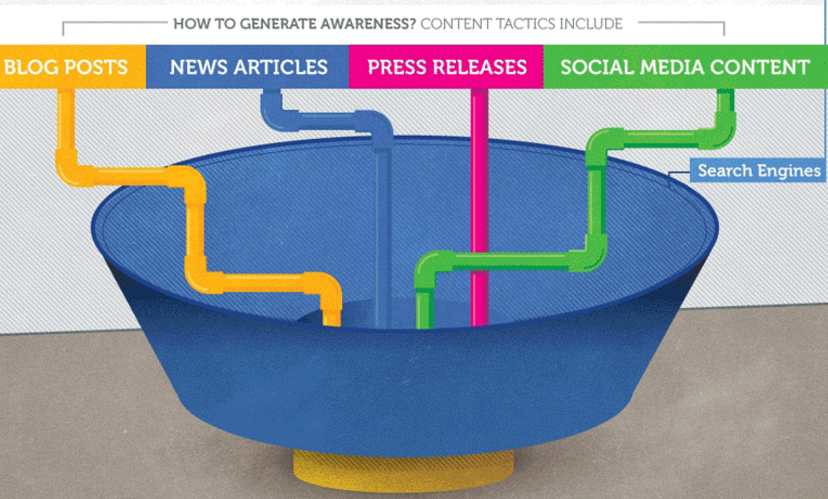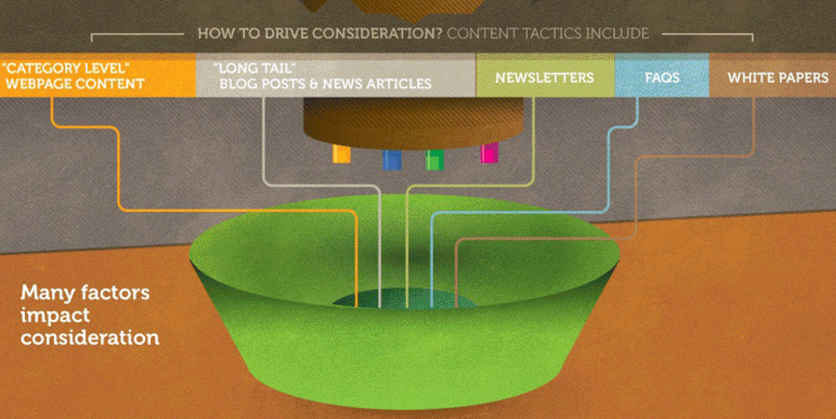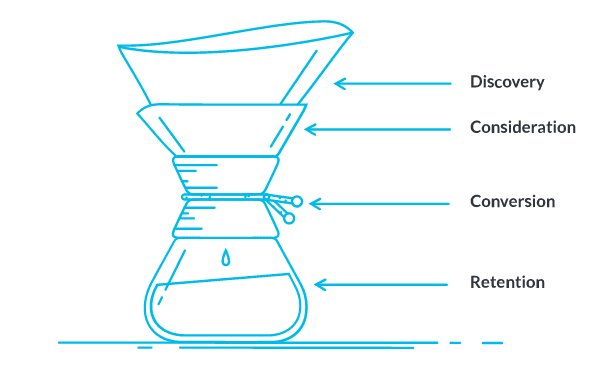Content marketing is an excellent strategy for boosting your business, but it’s certainly not “one piece fits all”.
Where does your business focus your content strategy?
We’ve found that there is often a perception that content is used mainly to pull in new customers or to nurture new leads. In truth though, content is an excellent strategy at any stage of the marketing sales funnel.
You may have come across the term “marketing funnel” before – depicting the stages through which your customers go from discovering your business to sticking around as a loyal customer. Content works for any of these stages; let’s explore how and why:
The Customer Marketing Funnel
First up, let’s look at a quick run-down of the customer marketing funnel and exactly what it means. As Moz rightly points out, in an ideal world this would look more like a cylinder than a funnel, because you’d hope that you were able to keep every prospect who crosses your path and turn them into a customer.
This is not to be though, which is probably a good thing! Most businesses will attract a lot of “looky-lous” and of course not all of those will turn out to be your ideal customer.
Hence the funnel. A shape which is wider at the top to represent all those prospects who discover your business and narrows out at the bottom representing customers who you successfully convert.
Source: Moz
You’ll notice from the Moz diagram that they split the funnel into four parts with retention at the bottom, whereas there are other funnel examples out there which go something like “awareness”, “evaluation”, “conversion.” We prefer the Moz model because it acknowledges that retaining your customers after conversion is super-important! In their model, the funnel is actually filtering into a flask, which makes sense representing a growing customer base.
We work with a lot of SaaS, though the same principles can be applied to other businesses. SaaS are always concerned with reducing churn, which is why giving sufficient focus to customer retention beyond conversion is important.
Even if you’re not a SaaS – let’s say you’re an ecommerce store – are you making the effort to retain the customer beyond one sale? That makes the difference between successful stores with longevity and those who die out. It’s hard work just to get a customer in the first place, so looking after them beyond the sale is important.
The Funnel Stages
It’s worth taking a quick look at each stage as a reminder of what they mean:
Discovery – The prospect has just found you by some means and is learning what you’re about.
Consideration – The prospect is aware of what you do and is weighing their options, deciding if what you offer is a good fit.
Conversion – The point at which the prospect is ready to make the decision to go with you.
Retention – The prospect is now a customer. This is where you need to be making efforts to keep them!
Mapping Content to the Funnel Stages
All content you produce for your business has some kind of purpose or end-goal, right? Otherwise, how will you know which metrics are appropriate to be measuring to determine the effectiveness of your content strategy?
Clearly, when viewed through the lens of a marketing funnel, your overarching goal for content is to move prospects onto the next phase, right up until after they’ve already purchased from you – this is when your goal becomes retention, or possibly getting them to upgrade if applicable.
At the same time, your prospects needs are different depending on which stage of the funnel they are at. David Skok wrote a piece in For Entrepreneurs explaining the buying cycle with a retail store as an example:
“Imagine that you wandered into a clothing store while walking around the neighborhood. You didn’t have a particular idea of anything you want to buy. You are approached by a hungry salesperson who is convinced they can get you to buy something. You are are annoyed by too much attention, and feel that they are ruining the peaceful browsing experience that you hoped to have.
Now imagine that you have gone into the same store. However In this situation, you have a urgent need to purchase a black sweater, and don’t have much time to waste. You want a salesperson to help you immediately, so you don’t waste your time looking for the item. However you can’t seem to get the attention of any of the salespeople. You are highly irritated by the lack of attention.”
In these two examples, you are at completely different stages of the cycle, hence your irritation by your needs not being met at either. In the first example you’re in the discovery phase, while in the second you’re at conversion already.
What does this mean for online businesses? It highlights the importance of catering your content to specific stages of the funnel so that you are meeting the needs of people there. Some general kind of informational content can be great, but you still need to have a good outline of who your ideal audience is and craft it to their preferences. Cast too wide a net and it is more difficult to attract the customers you want because they don’t immediately get that what you’re offering is for them.
Content for the Discovery Stage

Source: Business2Community
Going back to the browser in the store example, how irritating is the “hungry salesperson” approach? The same thing applies to the discovery stage online; if you want to entice people to browse and stay with you, don’t bombard them with “buy this stuff!” the minute they arrive on your website.
What should you do instead? Well, the prospect has shown interest and you want to keep them moving to the next stage, right? So your goals here are to generate brand awareness and provide educational or interesting content to reel the prospect in.
This is where you might consider things such as teaching them about the particular problem that your business solves. You may be solving a problem the customer knows they have. But sometimes with very new products, the customer hasn’t realized the problem yet. So, in those cases, you’ll need to start with that.
You might also create the kind of content which talks about best practices in your industry or common mistakes to avoid. The idea is to deliver something that will be of value to your ideal client so that it sparks their interest to continue through the funnel.
Examples include:
- Blog posts
- Guest blog posts
- Podcasts
- Infographics
- Social media posts
- Digital magazines
- Videos
- Microsite content
- Email newsletters
- Guides
Content for the Consideration Stage
If a prospect is still with you at this stage, congratulations, you’ve successfully sparked their interest. They are aware of the problem you solve and are looking for reasons to choose your solution. This doesn’t mean you leap right into “buy this stuff!”. No, often a more effective content strategy is to provide them with examples of how your product works and why it is a better solution than competitors.
Content at this stage might include:
- Case studies
- Free software demos or downloads
- Product videos or facts such as statistics (think: “X% of our customers improved (measure) by X% or more”)
- How-tos or best practices which feature or mention your product
Content for the Conversion Stage
Your prospects may have reached this stage via a journey through your content, or they’ve come straight to this point skipping the other stages because a friend recommended you to them or they’ve heard about you somewhere and know you can help.
This is the point where you can make a direct pitch (though, of course, “buy this stuff” is probably a bit too blatant!). It’s about giving them that final push which convinces them that purchasing is the thing to do.
Your content might include:
- Sales page – whether this is a “hard sell” or not should depend on what you know about your customer’s preferences.
- Webinar
- Customer stories
- Classes
- Testimonials or reviews
- Demos or free trials

Source: Business2Community
Content for the Retention Stage
The customer has taken the leap of faith and purchased from you, don’t neglect them once you’ve scored the sale! This means your content needs to keep delivering some kind of value to customers as well as keep your brand in their minds.
Content at this stage might include:
- Helpful tips for getting the most of the product, such as “insider’s guides.”
- Email newsletter specifically for customers.
- Special offers such as for upgrades or new products.
- “How-tos” from users.
Keep listening to your customers and understanding what topics are of interest to them. Providing them with useful content which helps them to be successful is a great way to channel loyalty and have them stick around.
Final Thoughts
Content is for every stage of the marketing funnel, though we often find businesses neglecting content for those customers they wish to retain!
All of your content should have an end-goal and have been thought out with regard to which stage of the funnel it is targeted at. Customers and prospects at each stage have different needs, so present content which addresses those needs.
Lastly, content can be used to keep current customers interested in your business. If you consistently deliver value for them with a great product coupled with quality content which actually helps them, you put yourself in a better position to retain them long-term.
